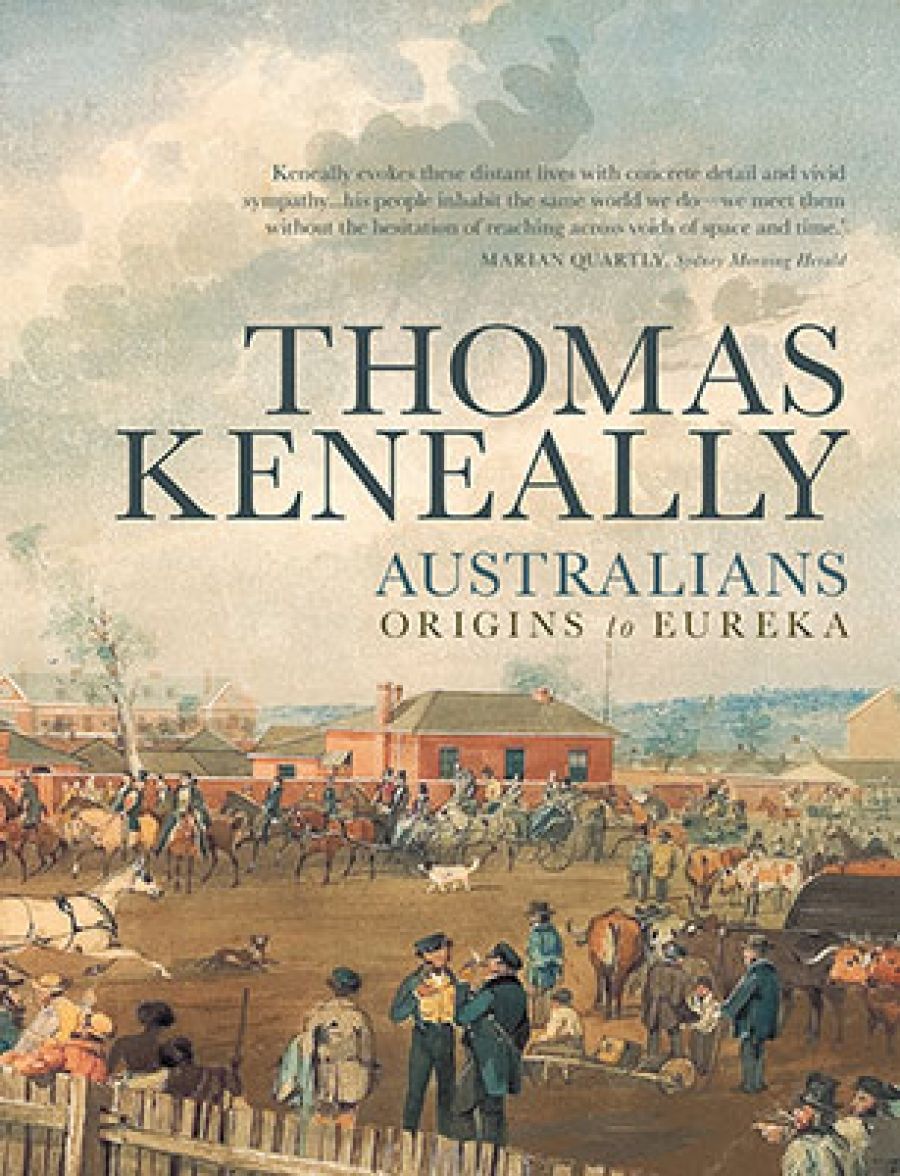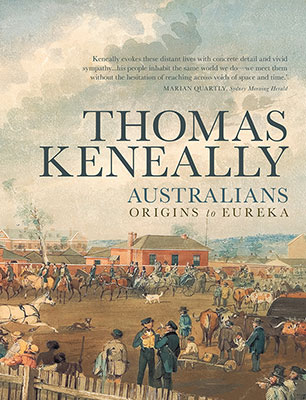
- Free Article: No
- Contents Category: Australian History
- Review Article: Yes
- Article Title: Creative history
- Article Subtitle: Meandering through Australian stories
- Online Only: No
- Custom Highlight Text:
A number of questions sprang to mind when I heard that Thomas Keneally was writing a three-volume history of Australia from its origins to the present. The first was to wonder how he would fit it into his crowded schedule. Clearly, though, this is not a problem. Keneally has just published another novel. More intriguing was the question as to what Keneally could add to the subject. After all, Australia is not lacking in colonial histories, many written by historians who are skilled writers. As Keneally is primarily a novelist, albeit one with a serious interest in our history and with several non-fiction studies under his belt, would the work reflect the conventions of historical fiction?
- Book 1 Title: Australians
- Book 1 Subtitle: Origins to Eureka, Volume 1
- Book 1 Biblio: Allen & Unwin, $59.99 hb, 639 pp
- Book 1 Cover Small (400 x 600):

In a prefatory note headed ‘The Way This Book Works’, Keneally states that he has chosen to focus on people whose tales ‘exemplify the major aspects and dynamisms of the Australian story’. For each one chosen there might have been many more, he continues, stating that the history ‘sets out to characterise Australia and, above all, individual Australians, in a manner that gives insights into the most significant aspects of the periods [dealt] with without exhaustively and thus cursorily engaging with every major actor’. Here, Keneally pre-empts criticisms about inclusions and omissions. But his choices are largely effective. Stories tracing the paths of those already well or partially known in Australian history – such as James Cook and Arthur Phillip, the Eora men Bennelong and Pemulwuy, William Wentworth, John Macarthur, Eliza Fraser, a young Henry Parkes and Eureka activist Raffaello Carboni – are interspersed with less familiar figures: convict women Sarah Bellamy and Mary Shields, convict and early newspaper proprietor George Howe, free settlers Sarah Davenport and Sarah Brunskill, to name just a few. There are fewer women than men, as there were in the colonies, and more whites than indigenous people; but women and Aborigines are included, not in a tokenistic way. The significance of race and racial tensions, and gender relations and the gender imbalance, are recurring, if not dominant, themes.
In a brisk prelude, the book imagines Australia without inhabitants, observes the arrival of those who would become the indigenous people, and speculates on their first contact with Europeans, before examining the more sustained intervention by the Dutch, the Portuguese and, finally, British navigators who sailed the world on voyages of discovery. The narrative proper starts with James Cook, an ‘apparently two-dimensional naval cipher’, a man who, Keneally surmises, ‘observed all human weakness but was not himself a player in it’. This sets the tone of Keneally’s characterisations. He takes what is known and uses it to explain the actions of individuals and, ultimately, their role in Australian history. The technique is particularly effective in enlivening well-worn tales of exploration, transportation and life in early Sydney. Joseph Banks ‘glimmered with charm’; convicts Mary and William Bryant plotted their escape from New South Wales ‘in the hope of becoming the first to rise from their pit and appear again on the shores of the known world’; John Macarthur was a ‘man of handsome features that must have satisfied the broad streak of narcissism in him’.
In his review of The People’s Train (ABR, September 2009), Patrick Allington wrote of Keneally’s ‘compulsive readability’. The chapters of Australians dealing primarily with the establishment of Sydney, which fill almost the first half of the book, are similarly compelling, if not always elegant: cumbersome sentences and confusing comma usage are frequent. But it is vigorous prose about keenly sketched people that carries the reader along with it; you want to find out what happens to the individual, even when you sometimes lose track of what is happening in the world. There is little sense of the broader context of European imperialism in the eighteenth and nineteenth centuries; little attention to what was going on in other parts of the world, other than events which directly influenced the course of colonialism in Australia, such as the American Revolution.
These chapters also prompt some expectations that the rest of the book doesn’t quite fulfil. The familiar story of Cook, the First Fleet and convict settlement, enlivened by previously unknown stories but nevertheless coherently themed, implies that some sort of continuous chronological narrative through the history of the Australian colonies up to Eureka will follow. This is not the case, and it is the focus on individuals that creates curious gaps. When, for example, the story of Governor Bligh making his ignominious exit from New South Wales in 1809 is related, we are told that he:
turned for Van Diemen’s Land and sailed up the Derwent, looking for hospitality from Lieutenant-Governor David Collins, Phillip’s old friend and former secretary, who had founded the settlement of Hobart, after abandoning what he saw as a less desirable site in Port Phillip Bay in present-day Victoria.
This is the first mention of Van Diemen’s Land since Keneally noted its sighting by the First Fleet. Until Keneally returns to explore the character of George Robertson, there is little mention of the island – or indeed of any other part of the continent.
There is no doubt that New South Wales was the dominant colony during the years covered by this volume (indeed, the only one for much of the period), and other colonies will doubtless receive more attention in later volumes, but there is a disjunction between the detailed coverage of early Sydney and of settlement of the Port Macquarie region of New South Wales and the cursory accounts of other colonies’ establishment, at least until Keneally, towards the end of the book, sets his sights on the Victorian gold discoveries and the Eureka uprising.
As it reaches the late 1830s and approaches the end of transportation to New South Wales, Keneally’s narrative, which has largely followed a basic chronology, diverges into a number of more disparate stories. The young, London-based Henry Parkes is introduced, although his influence on New South Wales must await the second volume. There are also sections on stories of captured women (Eliza Fraser and the mythical lost white woman of Gippsland), on the Myall Creek massacre (one of many instances of white brutality to indigenous peoples, but one of the few in which there were legal consequences for the white perpetrators) and on the early colonial press. These interesting but fragmentary accounts introduce a meandering quality to the book. When a theme is established – first the Irish diaspora, then gold discoveries and the build-up to Eureka – the narrative is more coherent.
Given Keneally’s sources and his general approach, this kind of fragmentation is inevitable. Some people leave more traces than others. For some, such as most convicts and early free settlers, records beyond the shipping records and punishment logs are sparse. For others, such as Wentworth and Parkes, there is an abundance of material. For indigenous peoples, particularly before the various Aboriginal Acts and missions, individuals were rarely mentioned in the written records of white observers, unless they were as prominent as Bennelong. The discrepancies between the quantity and kinds of sources available clearly helped shape the way in which Keneally presents the characters and their stories. Where firsthand accounts are available – Watkin Tench on early Sydney, Raffaello Carboni on Eureka, for example – Keneally deploys them well; elsewhere, gaps appear. These don’t necessarily need to be filled, but they could have been explained.
The focus of the book reflects Keneally’s abiding interests in the Irish, in radical thought and democratic movements. It certainly incorporates research from his past works. Convict Sydney was the focus of the novel Bring Larks and Heroes (1967) and the non-fictional A Commonwealth of Thieves: The Improbable Birth of Australia (2005); sections on the Irish political convicts were drawn from The Great Shame and the Triumph of the Irish in the English-Speaking World (1998); material is used from William Brodribb’s Recollections of an Australian Squatter, 1835–1883 (1883), on which Keneally also based much of Bettany’s Book (2000).
That many sources have been used by Keneally before does not diminish their value here, but the lack of any commentary on the selection, use and influence of sources is disconcerting. It is surprising that a greater attempt wasn’t made to assist the reader in navigating the book and locating sources. This is a long volume, with many chapters, all unnamed; the characters are plentiful and diverse, their stories profuse. When there is no theme to unite these stories, they can become unwieldy, their burden hard to grasp. In this they might be said to reflect the diverse, unwieldy, uncontainable nature of Australia’s varied population, but books don’t need to reflect their subject matter to this extent. The addition of descriptive chapter titles and the inclusion of page numbers in the notes section would have helped a great deal. There is a view that in general histories the structure needs to be kept out of sight; that footnotes should not intrude, that differences of opinion should not be canvassed, that the nature of sources need not be transparent. Here, a bit of artful scaffolding would not have gone astray.
There is also a publishing orthodoxy that holds that what the general reader likes to read about most is other people, and that popular interest in history focuses on biography, historical fiction or narrative history. There is much validity in this. Knowledge of what people were like in the past, of their motivations, foibles and failings, humanises them and enables the reader to visualise the past more clearly. Thomas Keneally has not written historical fiction, but he has covered the popular bases, and largely it works. He shows people who love, hate, commit crimes or find religion, get drunk, have children and build houses, who displace others or are in turn displaced, who resist invasion, perpetrate violence or fight for social justice. Some also have extraordinary political, monetary or social ambitions; all, in Keneally’s portrayal, contribute to forming Australia.


Comments powered by CComment